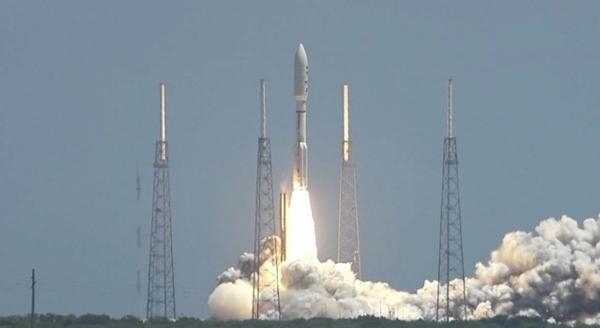Sat, Aug 06, 2011
Lifts Off From Cape Canaveral Air Force Station in
Florida.
NASA's solar-powered Juno spacecraft lifted off from Cape
Canaveral Air Force Station in Florida at 1225 EDT Friday to
begin a five-year journey to Jupiter. Juno's detailed study of the
largest planet in our solar system will help reveal Jupiter's
origin and evolution. As the archetype of giant gas planets,
Jupiter can help scientists understand the origin of our solar
system and learn more about planetary systems around other
stars.
Image Courtesy NASA TV

"Today, with the launch of the Juno
spacecraft, NASA began a journey to yet another new frontier," NASA
Administrator Charles Bolden said. "The future of exploration
includes cutting-edge science like this to help us better
understand our solar system and an ever-increasing array of
challenging destinations."
After Juno's launch aboard an Atlas V rocket, mission controllers
now await telemetry from the spacecraft indicating it has achieved
its proper orientation, and that its massive solar arrays, the
biggest on any NASA deep-space probe, have deployed and are
generating power. "We are on our way, and early indications show we
are on our planned trajectory," said Jan Chodas, Juno project
manager at NASA's Jet Propulsion Laboratory in Pasadena, Calif. "We
will know more about Juno's status in a couple hours after its
radios are energized and the signal is acquired by the Deep Space
Network antennas at Canberra."
Juno will cover the distance from Earth to the moon (about 250,000
miles) in less than one day's time. It will take another five years
and 1,740 million miles to complete the journey to Jupiter. The
spacecraft will orbit the planet's poles 33 times and use its
collection of eight science instruments to probe beneath the gas
giant's obscuring cloud cover to learn more about its origins,
structure, atmosphere and magnetosphere, and look for a potential
solid planetary core.
With four large moons and many smaller moons, Jupiter forms its
own miniature solar system. Its composition resembles that of a
star, and if it had been about 80 times more massive, the planet
could have become a star instead. "Jupiter is the Rosetta Stone of
our solar system," said Scott Bolton, Juno's principal investigator
from the Southwest Research Institute in San Antonio. "It is by far
the oldest planet, contains more material than all the other
planets, asteroids and comets combined, and carries deep inside it
the story of not only the solar system but of us. Juno is going
there as our emissary -- to interpret what Jupiter has to say."
Juno's name comes from Greek and Roman mythology. The god
Jupiter drew a veil of clouds around himself to hide his mischief,
and his wife, the goddess Juno, was able to peer through the clouds
and reveal Jupiter's true nature.
More News
Airbus Racer Demonstrator Makes Inaugural Flight Airbus Helicopters' ambitious Racer demonstrator has achieved its inaugural flight as part of the Clean Sky 2 initiative, a corners>[...]
A little Bit Quieter, Said Testers, But in the End it's Still a DA40 Diamond Aircraft recently completed a little pilot project with Lufthansa Aviation Training, putting a pair of >[...]
Line Up And Wait (LUAW) Used by ATC to inform a pilot to taxi onto the departure runway to line up and wait. It is not authorization for takeoff. It is used when takeoff clearance >[...]
Contributing To The Accident Was The Pilot’s Use Of Methamphetamine... Analysis: The pilot departed on a local flight to perform low-altitude maneuvers in a nearby desert val>[...]
From 2015 (YouTube Version): Overcoming Obstacles To Achieve Their Dreams… At EAA AirVenture 2015, FedEx arrived with one of their Airbus freight-hauling aircraft and placed>[...]
 Airbus Racer Helicopter Demonstrator First Flight Part of Clean Sky 2 Initiative
Airbus Racer Helicopter Demonstrator First Flight Part of Clean Sky 2 Initiative Diamond's Electric DA40 Finds Fans at Dübendorf
Diamond's Electric DA40 Finds Fans at Dübendorf ANN's Daily Aero-Term (04.23.24): Line Up And Wait (LUAW)
ANN's Daily Aero-Term (04.23.24): Line Up And Wait (LUAW) NTSB Final Report: Extra Flugzeugbau GMBH EA300/L
NTSB Final Report: Extra Flugzeugbau GMBH EA300/L Classic Aero-TV: 'Never Give Up' - Advice From Two of FedEx's Female Captains
Classic Aero-TV: 'Never Give Up' - Advice From Two of FedEx's Female Captains



